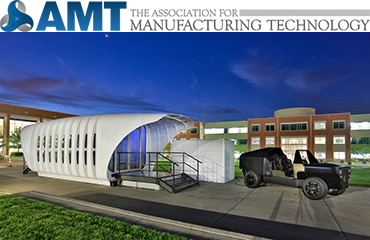EMERGING TECHNOLOGY CENTER (ETC) AT IMTS WILL SHOWCASE HOME, VEHICLES AND BIONIC HUMAN
The Association For Manufacturing Technology, will feature Additive Manufacturing, Smart Manufacturing and Integrated Energies in its Emerging Technology Center (ETC) at IMTS – The International Manufacturing Technology Show, Sept. 12 – 17, 2016.

AMT created the ETC as a showcase for current and near-future state-of the art manufacturing technologies. Premier exhibits at IMTS 2016 include three “proof of concept” additive manufacturing (3D printed) displays:
- The “additive bionic human” showing additive manufactured medical implants and body parts.
- The AMIE (Additive Manufacturing Integrated Energy) project from the Department of Energy’s (DOE) Oak Ridge National Laboratory (ORNL) demonstrates rapid innovation through additive manufacturing to connect a natural gas-powered hybrid electric vehicle to a high-performance building that produces, consumes and stores renewable energy.
- An all-electric Shelby Cobra replica and a 1952 Willys Army Jeep reproduction. Using Big Area Additive Manufacturing, or BAAM technology, the ORNL advanced manufacturing team produced the Shelby Cobra replica in only 24 hours at DOE’s Manufacturing Demonstration Facility at ORNL.
“The ETC is world-renowned for showcasing projects and disruptive technologies that were previously known to only a few. We want the ETC to challenge pre-conceived notions of how manufacturing performs at its best,” says Peter R. Eelman, Vice President – Exhibitions & Business Development at AMT, which owns and manages IMTS.
Since its debut at IMTS 2004, the ETC has become a ‘must visit’ destination. For example, the world’s first 3D printed car was built live in the ETC exhibit at IMTS 2014, and the now-famous “Strati” vehicle received prime-time media acclaim. At IMTS 2016, 3D printed cars from Local Motors (one of the pioneers behind the Strati) will be available for rides at an indoor test track in C Hall of the North Building, demonstrating how quickly extraordinary technology can become part of popular culture.
The AMIE Project
The AMIE Project, led by Oak Ridge National Laboratory, examines and demonstrates how additive manufacturing can be used to create a symbiotic relationship between energy and the way we live.
“The premise of the AMIE project is to merge the energy streams of our homes and vehicles. It changes the way we think about generating, consuming and storing power,” says Dr. Craig Blue, Oak Ridge National Laboratory. “From concept to reality in just 12 months, the project provides a preview of the potential of energy efficiency and sustainability.”
With AMIE, the home can use energy from the grid or from the photovoltaic panels integrated into its roof, while battery in the home stores surplus solar energy for cloudy days. The home also features a wireless charging pad in the driveway. Bi-directional wireless energy flow allows the building to charge the hybrid vehicle’s battery, and the vehicle can also supply energy to the home during peak demand. Additionally, the home can send excess energy back into the grid for consumption elsewhere.
The Additive Bionic Human
The additive bionic human portion of the ETC, being developed in conjunction with additive manufacturing leader EOS North America, will feature an interactive image of the human body that highlights medical implants and prosthetics now (or soon to be) manufactured by 3D printing. Touch screen technology will take a participant deeper into the story from three points of view: the patient view, the medical view (the medical science behind the part) and the 3D technology view.
Actual printed body parts on display included cranial implants, tracheal implants, dental implants, rib cage, leg prosthesis, joints and hands. The 3D printed hand open source CAD files are accessible for free as the part of the efforts of the Enable Community Foundation, which advances and extends e-NABLE, a global network of “digital humanitarians.”
“Designing, fabricating and providing free prosthesis-like hands demonstrates how companies, people and technology converge to enrich humanity,” says Eelman.
In addition to whole parts, “bio-printing” shrinks additive body parts to the cellular level, such as printing liver tissue for drug research or printing blood vessels and cartilage for replacement of a damaged meniscus.
“Tissue engineering is a growing science,” says Eelman. “The implications of printing living tissue structures in the medical industry are astounding, and we want to show people some of the possibilities.”
An App for Staying Current
One of the biggest challenges manufactures face is staying current with new technology. So that manufacturers can keep abreast with daily developments, AMT will unveil the first iteration of a new software application (app) that tracks and provides readers with the latest technology advancements.
“This app goes beyond a traditional RSS feed. It’s a true aggregator of manufacturing research from multiple sources that custom-compiles research as defined by the user,” says Eelman. “The app debuts as an information piece in AMT’s ETC, and visitors can test some of the beta-versions in the AMT Experience.”
With its location off the Grand Concourse in the North Building, the ETC should be the first “must stop” destination for IMTS visitors.
IMTS – International Manufacturing Technology Show
The largest and longest running manufacturing technology trade show in the United States is held every other year at McCormick Place in Chicago, Ill. IMTS 2016 will run Sept. 12-17. IMTS is ranked among the largest trade shows in the world. Recognized as one of the world’s preeminent stages for introducing and selling manufacturing equipment and technology, IMTS attracts more than 114,000 visitors from every level of industry and more than 112 countries. IMTS is owned and managed by AMT – The Association For Manufacturing Technology.
For more information, visit www.IMTS.com or www.AMTonline.org.











































